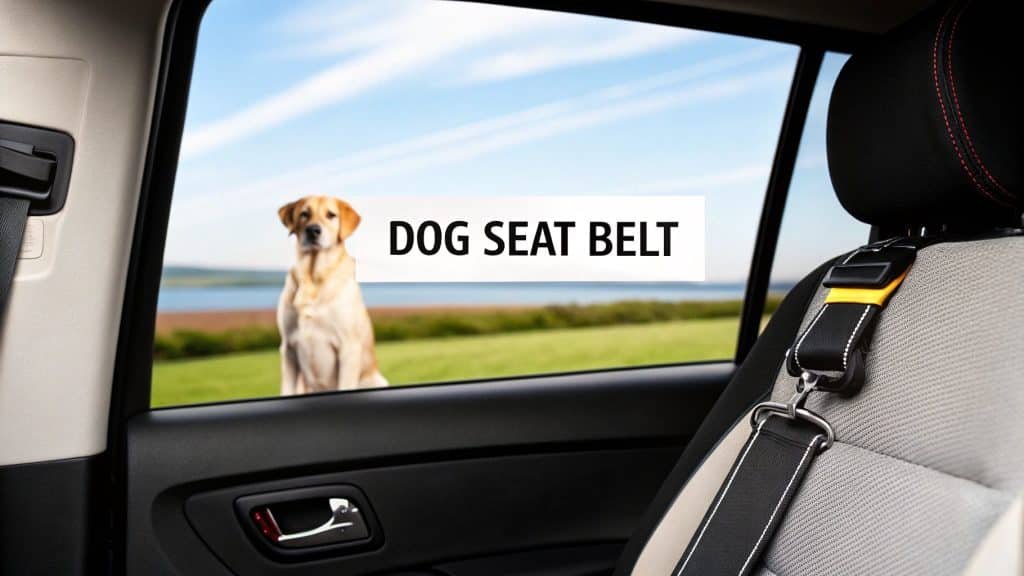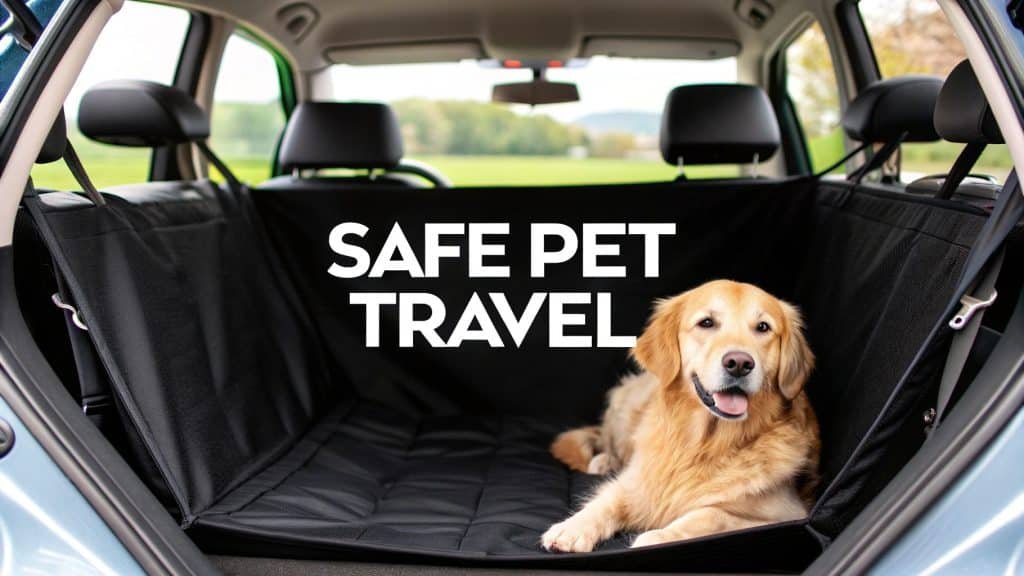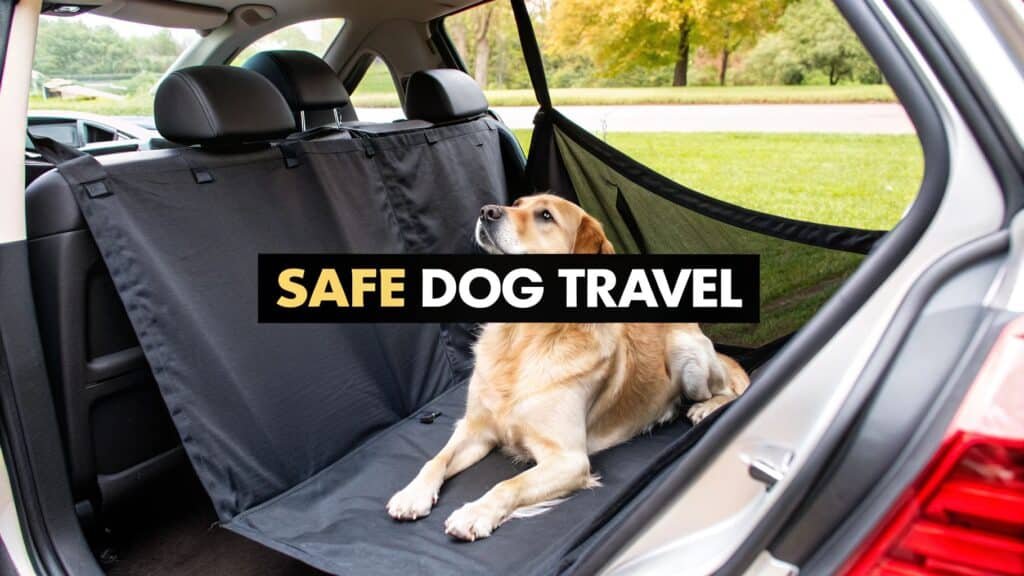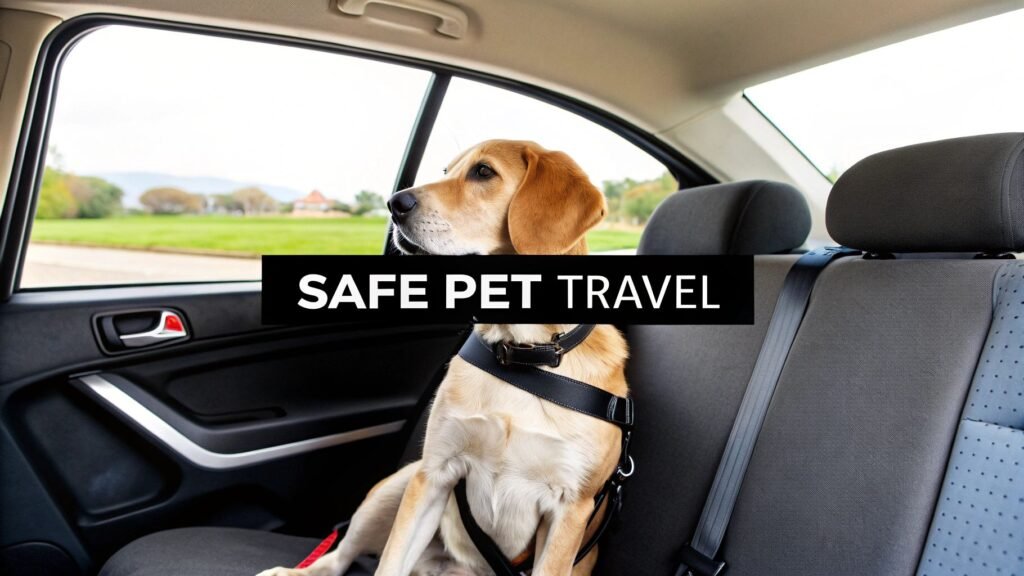The Ultimate Pet Car Hammock Guide
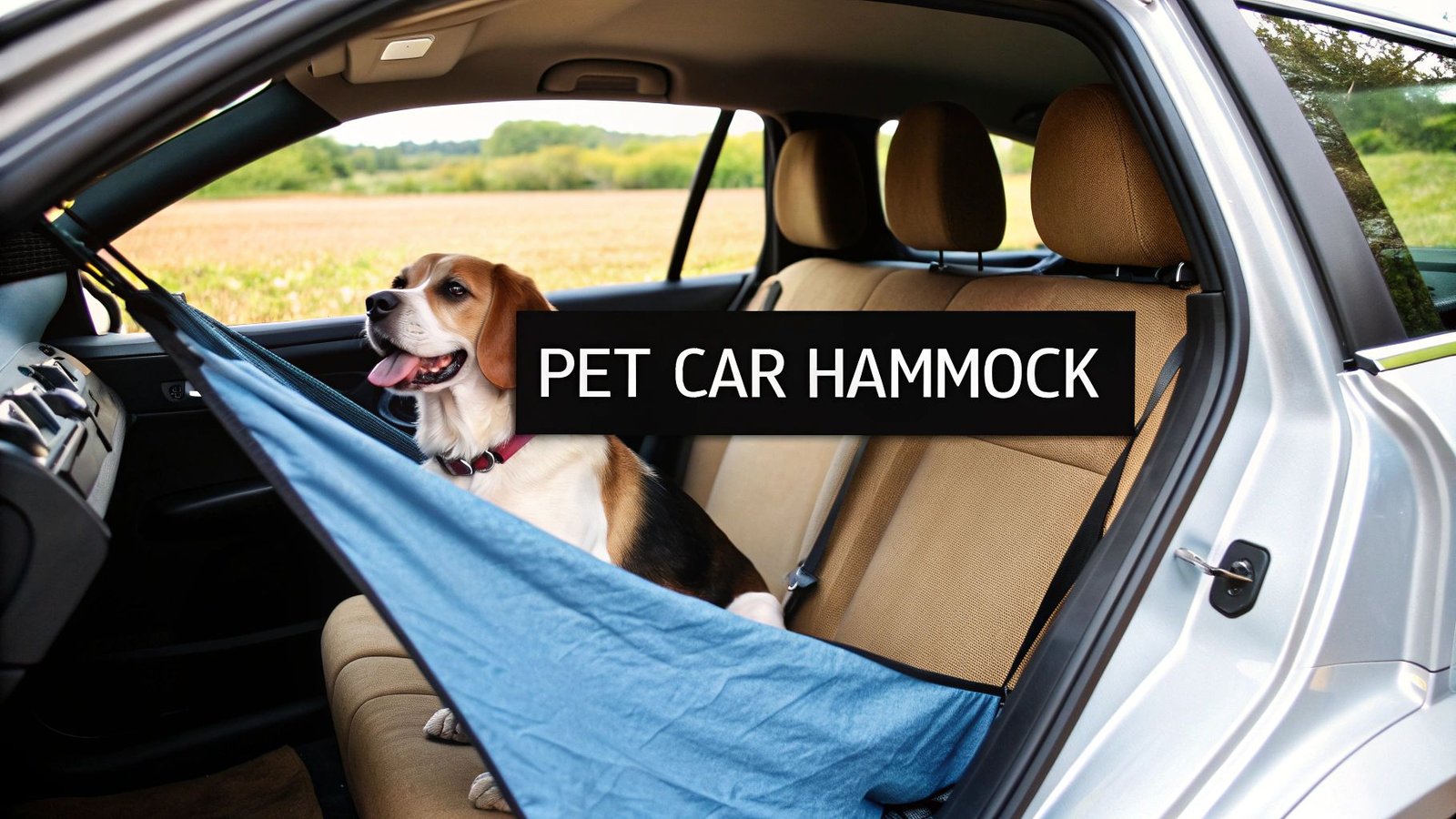
If you’ve ever traveled with your dog, you know the drill. The joy of having them along for the ride is often tempered by the inevitable mess left behind—fur embedded in the upholstery, muddy paw prints everywhere, and the occasional scratch mark. That’s where a pet car hammock comes in. It’s one of those simple, brilliant accessories that makes you wonder how you ever managed without it.
Essentially, it’s a durable, often waterproof, sling that stretches across your back seat. It hooks onto the front and rear headrests, creating a cozy, contained space for your dog and a protective barrier for your car’s interior. No more dogs tumbling into the footwell during a sudden stop, and no more post-adventure cleanup headaches.
Why a Hammock Is a Game Changer for Pet Travel
Let’s be real—dogs and clean cars don’t naturally mix. One minute you’re cruising down the highway, the next your wet, muddy pal is gleefully shaking off pond water all over your seats. A pet car hammock is your first line of defense, turning your entire back seat into a secure, easy-to-clean doggy zone.
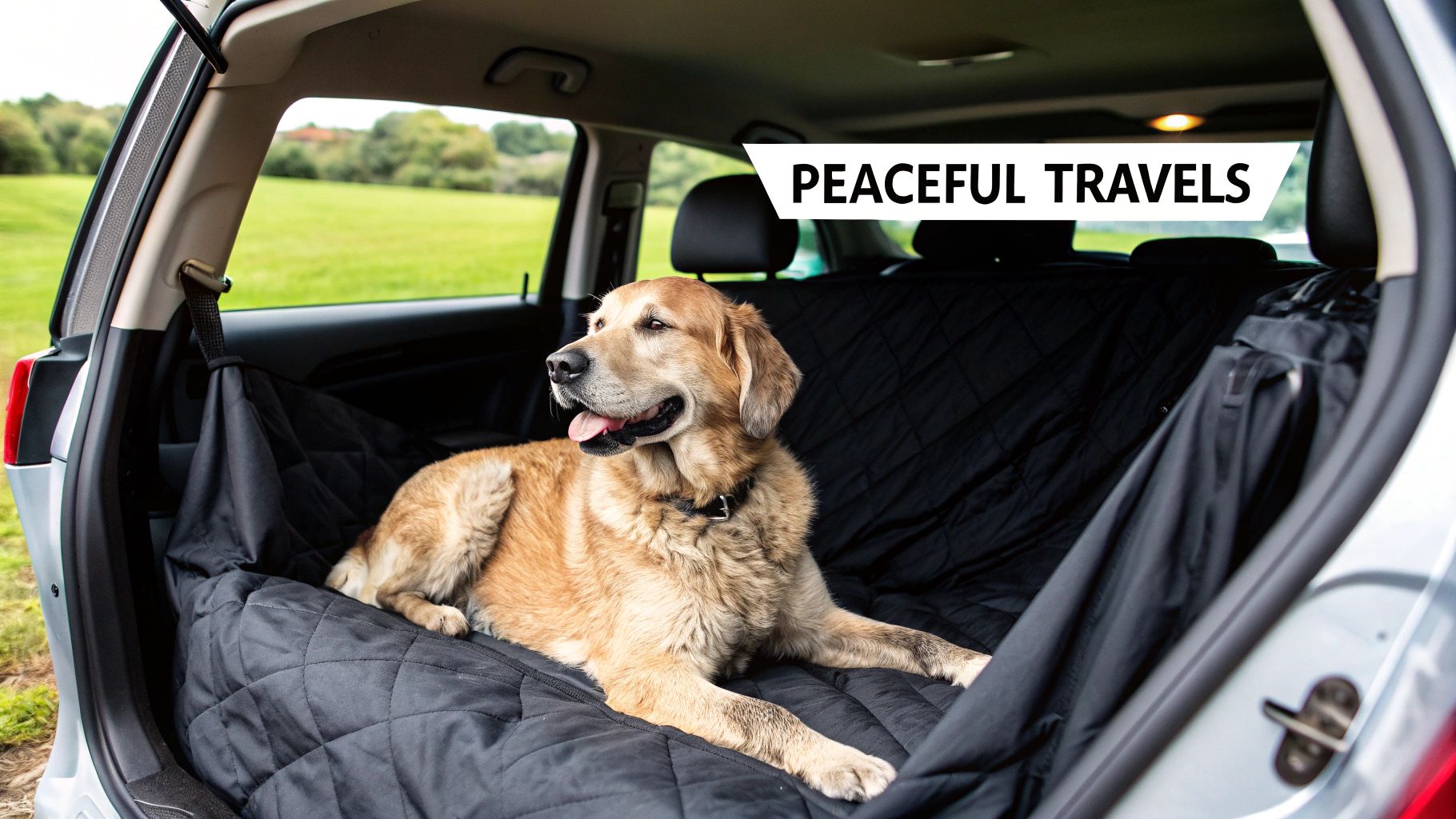
Think about that trip to the hiking trail. Instead of cringing as your tired, dirty pup hops back into the car, you can just relax. The hammock catches all the dirt, fur, and whatever else they’ve collected. Once you’re home, a quick shake-out and a wipe-down are all it takes. It’s not just an accessory; it’s peace of mind on four wheels.
It’s also a huge win for safety. Many dogs, especially anxious ones, try to join you in the front seat, which is a major distraction. The hammock creates a soft but effective barrier that keeps them safely in the back without making them feel closed off.
The Dual Benefits for You and Your Pet
A good pet car hammock is a win-win. It solves the pet owner’s biggest travel problem (the mess) while making the ride safer and more comfortable for the dog.
For You, the Owner:
- Complete Interior Protection: It’s a shield against everything—claws that can shred leather or fabric, shedding that seems to become part of the seat, and the occasional “oops” moment.
- Cleanup That’s Actually Easy: Most are made from waterproof, heavy-duty materials. Just wipe them down, hose them off, or even toss some models in the washing machine.
- Protects Your Car’s Value: Keeping your interior looking brand new is a huge plus when it comes time to sell or trade in your vehicle.
For Your Pet:
- A Much Safer Ride: The sling design is a game-changer. It prevents your dog from being jolted into the footwell during a hard brake.
- Less Travel Anxiety: Creating a familiar, den-like space can be incredibly calming for dogs who get nervous in the car.
- A More Comfortable Trip: It gives them a stable, consistent surface to lie on, so they can truly settle in and relax.
By creating a contained and predictable space, a pet car hammock not only protects your car but also helps manage your pet’s travel anxiety, making every journey more enjoyable for everyone involved.
It’s no surprise these have become so popular. Pet owners are actively looking for better ways to travel with their companions. In fact, the market for pet travel products has ballooned, reaching an estimated USD 1.21 billion in 2024. This boom is driven by people just like us who want safer, cleaner, and more comfortable adventures with their pets. You can learn more about the pet travel market growth and see just how big this trend is. Understanding these benefits is the first step toward picking the perfect one for your needs.
How to Choose the Right Pet Car Hammock
Choosing a pet car hammock can feel overwhelming with all the options out there. But if you know what to look for, you can quickly cut through the noise. It really boils down to four things: the material it’s made from, how well it fits your car, its safety features, and a few clever design details.
Getting this right isn’t just about keeping your seats clean. It’s about creating a safe, comfortable den for your dog on every single trip.
Material and Durability
The fabric is your first line of defense against everything your dog can throw at it—muddy paws, sharp claws, and the inevitable drool. Most quality hammocks use a heavy-duty Oxford fabric. Keep an eye out for a high “denier” count, like 600D, which tells you the material is thick, tough, and built to last.
Some hammocks add a soft, quilted micro-suede top for extra comfort. That’s great, but the real magic is underneath. Don’t settle for “water-resistant.” You need a truly waterproof hammock, which usually means it has a TPU (thermoplastic polyurethane) backing. This non-toxic layer ensures that no liquid—whether it’s from a spilled water bowl or an accident—will ever soak through to your upholstery.
For dogs who are still potty training or get car sick, I always recommend adding a reusable dog pee pad blanket on top. It gives you an extra layer of protection and makes cleanup so much easier.
Finding the Perfect Fit
This is one of those times where a few minutes with a tape measure will save you a huge headache later. A hammock that’s too big will bunch up and look sloppy, and one that’s too small leaves your seats vulnerable.
- Measure your backseat from door to door to get the total width.
- Compare it to the product specs. Most standard hammocks are around 54 inches wide, which is a perfect fit for most sedans and smaller SUVs.
- If you have a bigger ride, like a full-size SUV or a truck, you’ll want to search for an “XL” or “truck-sized” version. These are typically 60 inches wide or even larger.
A snug fit is a safe fit. You’re aiming for a taut, secure sling that covers everything. It prevents gaps where a paw could get stuck or dirt could sneak through to the floor.
Safety Features Are Non-Negotiable
Beyond the fabric and fit, the safety features are what truly matter. These are the components that keep your dog stable and secure when the car is moving.
Here’s what you absolutely need to look for:
- Non-Slip Backing: This is a must-have. A rubberized or silicone-dotted texture on the bottom grips the seat and stops the hammock from sliding around on sharp turns or during sudden stops. A shifting surface can really scare a dog.
- Seat Anchors: These are little tubes you tuck into the crevice between the seat back and the cushion. They lock the hammock in place so it can’t slide forward or bunch up.
- Seatbelt Openings: Look for Velcro or zippered slots that let you access the seatbelt buckles. This is critical because it allows you to properly secure your dog with a crash-tested safety harness.
Design Details That Make a Difference
Finally, it’s the little things that can make a hammock go from good to great. My personal favorite is the mesh window between the two front seats. It’s a game-changer. It lets air flow into the back, keeping your dog cool, and more importantly, it lets them see you. For an anxious pup, that visual connection can make all the difference.
Another brilliant feature is side flaps. These are extra panels that zip up and cover the inside of your doors. They protect against scratches as your dog jumps in and out and cleverly block that gap between the seat and the door. It’s no surprise that the market for hammocks with side flaps is projected to grow by 8.2% annually through 2033—owners clearly see the value in that extra protection.
Pet Car Hammock Feature Comparison
To help you visualize what might work best for your setup, here’s a quick breakdown of common features and where they shine.
| Feature | Best For Small Cars (Sedans) | Best For Large Vehicles (SUVs/Trucks) | Key Benefit |
|---|---|---|---|
| Standard Width (~54″) | ✓ | Provides a snug, secure fit without bunching. | |
| XL Width (60″+) | ✓ | Ensures full seat coverage in wider vehicles. | |
| Mesh Viewing Window | ✓ | ✓ | Improves airflow and reduces pet anxiety. |
| Zippered Side Flaps | ✓ | ✓ | Protects doors from scratches during entry/exit. |
| Seat Anchors | ✓ | ✓ | Prevents the hammock from shifting or sliding. |
| Convertible Design | ✓ | Allows half the hammock to fold down for a human passenger. |
Ultimately, the best car hammock is one that fits your vehicle correctly and has the safety features to give you peace of mind on the road.
Getting Your Hammock Installed for a Rock-Solid Fit
You’ve picked out the perfect pet car hammock. Great! Now for the most important part: installing it correctly. A floppy, sagging hammock isn’t just annoying; it’s a safety hazard. The whole point is to create a stable, secure space for your dog, and that all comes down to a snug installation.
Think of it this way: a loose hammock can shift during a sudden stop or a sharp turn, which is exactly what you’re trying to prevent. We’re aiming for a wobble-free fit that keeps your pup safely contained and your car seats pristine.
Start With the Back Headrests
First things first, unfold the hammock and lay it out across your backseat. You’ll see two straps meant for the rear headrests. Go ahead and loop each one around its headrest post and click the buckle shut.
Don’t worry about getting them super tight right now—just get the hammock hanging in place. We’ll dial in the tension in a bit. A little tip: if your headrests are adjustable, pop them up an inch or two. It makes sliding the straps underneath so much easier.
This infographic breaks down the key steps for getting a secure fit, really highlighting how to get those straps just right.
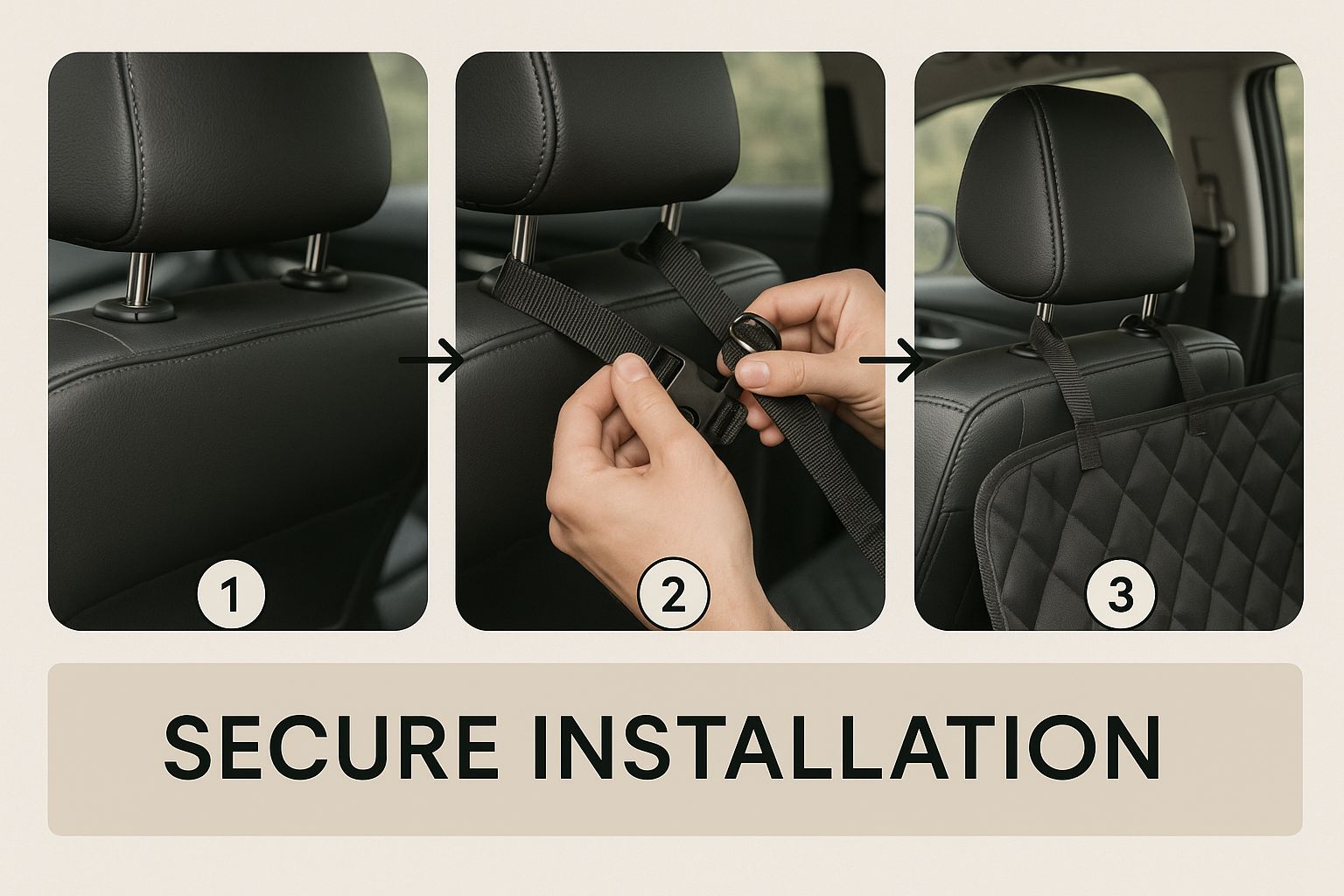
As you can see, it’s all about adjusting and tightening until the hammock is taut and stable.
Lock in Those Seat Anchors
Now, look for the seat anchors. They might seem small, but these little tube-shaped pieces are your secret weapon against slippage. You’ll usually find them on the underside of the hammock.
Shove each anchor deep into the crack where the back of the seat meets the bottom cushion. You want to wedge them in there good and tight. This is what keeps the whole thing from sliding forward every time your dog repositions. Honestly, this is the step most people get wrong. They either forget it or don’t push the anchors in far enough, and the hammock ends up bunched up at the first stoplight.
Secure the Front and Get the Tension Just Right
With the back securely anchored, let’s move to the front. Take the remaining two straps, loop them around the front seat headrests, and buckle them up.
Now it’s time to fine-tune. Go around to all four straps—front and back—and pull them until the hammock is taut. You’re looking for a firm, almost level surface with very little sag. The goal is snug but not strained. You shouldn’t be reefing on the straps so hard that the buckles are groaning or your headrests feel stressed.
My Go-To Check: Once you think it’s right, give the hammock a good, firm shake from side to side. If it moves more than an inch or two, it’s too loose. Go back and tighten the straps a bit more. This little “wobble test” is my final confirmation that it’s ready for my dog.
Last but not least, if your hammock has those zippered side flaps (and I hope it does!), zip them up to protect your doors from drool and scratches.
Now you’re ready to feed your dog’s safety harness through the seatbelt slots. Remember, the harness tether should always click directly into the car’s seatbelt buckle. Never attach it to the hammock itself. This combination is the gold standard for safe car travel: the hammock contains them, and the harness-seatbelt combo restrains them.
Creating a Safe and Comfortable Travel Space
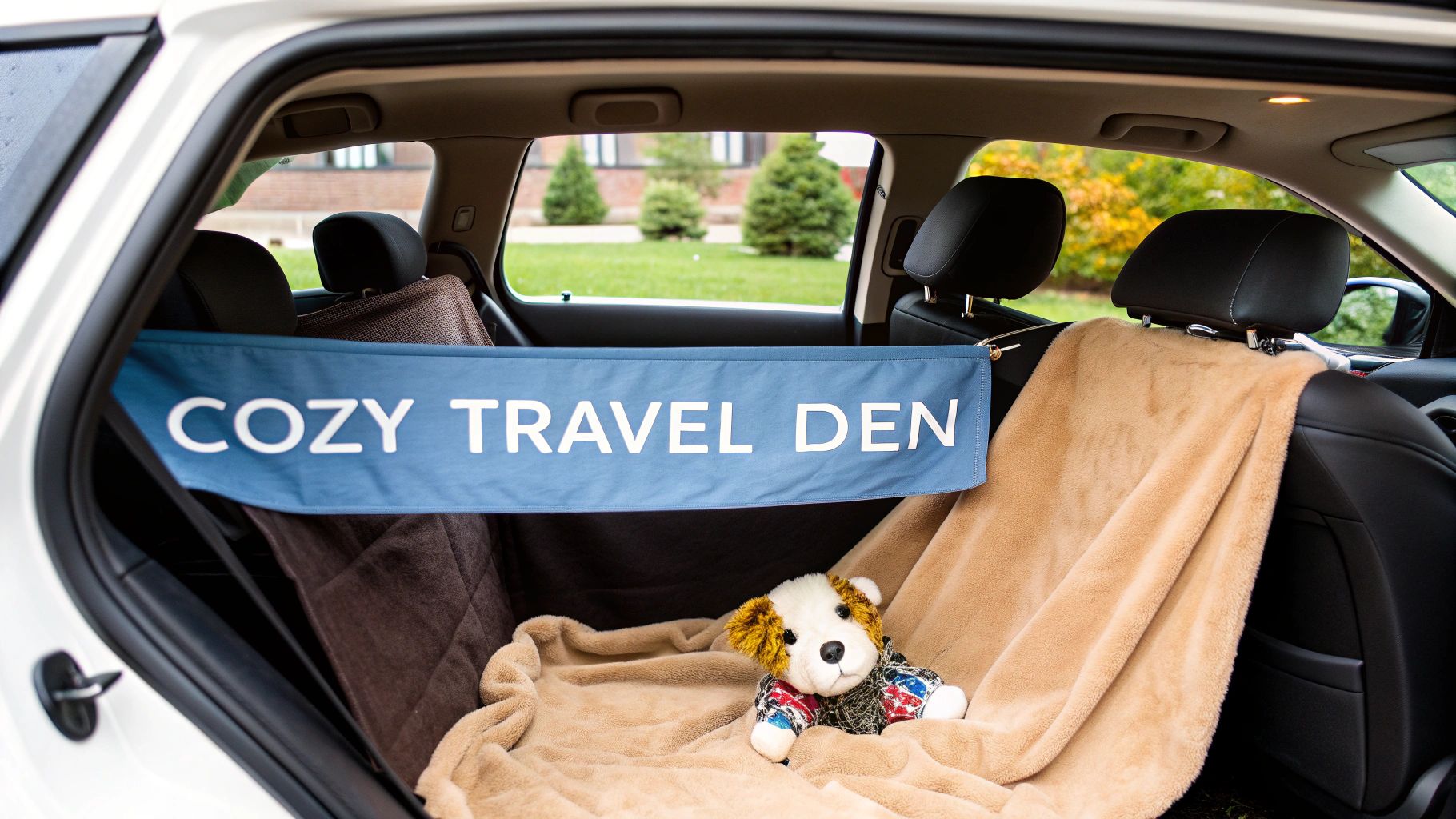
You’ve got your pet car hammock installed, which is a fantastic start. But now the real work begins: turning it from just a seat protector into a cozy, stress-free den your dog is actually excited to jump into. Think of it this way—the shift from a familiar home to a moving car can be a little jarring for a dog. A few simple touches can smooth out that transition beautifully.
Before you even think about starting the car, let your dog get acquainted with the hammock on their own terms. Drape it over a chair in the living room or just lay it on the floor. Let them sniff it, walk on it, maybe even take a nap on it. Sprinkle a few of their favorite treats on the surface to create an instant positive vibe.
Once they see the hammock as a friendly object, pop it in the car and make it feel like home. The easiest way to do this? Add a familiar blanket or a well-loved squeaky toy. These items carry comforting scents that can ground an anxious dog, making the new space smell like their own safe territory.
Safety First Always
Comfort is wonderful, but safety is everything. This is probably the most critical takeaway for traveling with your dog: the hammock is for containment, not restraint. This is a common and dangerous mistake. Your dog still needs to be properly secured with a crash-tested safety harness.
Here’s how to do it right every single time:
- Harness, Never a Collar: Attaching a seatbelt tether to a dog’s collar is a recipe for disaster. A sudden stop can cause severe neck or tracheal injuries. Always use a harness.
- Connect Directly to the Car: Your hammock should have openings that let you access the seatbelt buckle. Thread the car’s seatbelt through the slot, click it in, and then clip the tether directly to the D-ring on the back of your dog’s harness.
- Don’t Use Hammock Attachments: The straps and clips on the hammock itself are not designed to handle the force of a collision. Never attach a safety tether to any part of the hammock.
Getting the right gear is non-negotiable. If you need to upgrade, you can browse a great selection of crash-tested harnesses and safety tethers to match your dog’s size and build.
Enhancing the Travel Experience
With the serious safety stuff sorted, you can focus on making the ride enjoyable. If your hammock features a mesh window between the front seats, you’re already ahead of the game. It’s great for airflow, which helps prevent overheating, and it lets your dog see you—a simple visual that can be incredibly reassuring.
For any trip longer than a quick run to the store, make sure fresh water is available. A travel-friendly, no-spill water bowl tucked into a corner of the hammock is a perfect solution for keeping your pup hydrated without soaking your car. It’s no surprise that the pet travel accessories market is booming, with a projected value of $7.90 billion in 2025. This tells us that pet owners everywhere are demanding better, safer, and more convenient products. You can even discover more insights about pet travel trends and see where the industry is headed.
By combining a secure installation with familiar comforts and proper safety restraints, you’re not just protecting your car—you’re creating a first-class travel experience for your best friend.
Keeping Your Pet Hammock Clean and Fresh
After a few muddy hikes or a slobbery trip to the dog park, your car hammock is going to look… well, loved. Keeping it clean isn’t just about appearances or keeping your car from smelling like a kennel; it’s about making sure the hammock lasts and gives your pet a hygienic place to ride.
The good news is that most quality hammocks are built for easy cleanup. For the everyday stuff—a little drool, a few paw prints—a quick spot clean is all you need.
I just keep a damp cloth in the car for this. A little wipe-down with some water, maybe a touch of mild soap, handles 90% of the mess right then and there. It stops little messes from becoming big, set-in stains.
When a Deeper Clean is Needed
Then there are the days when a simple wipe just won’t do. We’ve all been there—the post-swim wet dog smell, a carsick puppy, or a full-on mud bath adventure. For that, you’ll need to pull out the big guns.
Before you even think about washing it, take the hammock out and give it a really good shake. You’ll be amazed at how much fur, dirt, and stray kibble comes flying out.
Many hammocks are machine washable, which is a lifesaver. But don’t just toss it in—always, always check the manufacturer’s tag first.
- Washing Machine Settings: Stick to a gentle cycle with cold water. This is crucial for protecting the fabric and any waterproof layers.
- The Right Detergent: I recommend using a mild, pet-safe detergent. You don’t want any harsh chemicals irritating your dog’s skin.
- Drying is Key: Never put your hammock in a machine dryer. That high heat will absolutely destroy the non-slip backing and waterproof membrane. The best way is to hang it up to air dry. If you can, keep it out of direct, harsh sunlight to prevent the color from fading over time.
A clean hammock is a safe hammock. Washing it is the perfect time to give everything a quick once-over. You can inspect the straps, buckles, and seams for wear and tear before it becomes a real problem on the road.
Don’t Forget Regular Inspections
Beyond just cleaning, I make it a habit to inspect our hammock every month or so. It only takes a minute and gives me real peace of mind.
Check for any fraying on the headrest straps and make sure the buckles still click in securely. Take a look at the seat anchors to see if any plastic is getting brittle or showing cracks. Finding a weak spot before it fails is one of the most important things you can do for your pet’s safety.
For more great tips on keeping all your pet’s gear in top condition, check out our resources on grooming and cleaning supplies.
And a final tip on storage: once it’s completely dry, fold it up and keep it somewhere cool and dry. This prevents any mildew from growing while it’s waiting for your next adventure.
Your Top Questions About Pet Car Hammocks, Answered
Once you get your new pet hammock home and set up, you might find yourself with a few lingering questions. That’s completely normal! Getting the hang of a new piece of gear always comes with a small learning curve.
We’ve heard all the common “what ifs” from other pet owners, so we’ve put together answers to the most frequent questions right here.
Can I Put the Hammock in My Front Seat?
This one is a hard no, and for a critical reason: airbags.
Pet car hammocks are designed only for the backseat. In a collision, your car’s front airbags deploy with enough explosive force to seriously injure or even kill a pet. The whole point of the hammock is to create a safe, contained space in the back, far away from that danger. For your dog’s safety, always keep them—and their hammock—in the rear of the vehicle.
Will This Hammock Actually Fit My Car?
This is a great question because, let’s face it, cars come in all shapes and sizes. Most hammocks are made to have a “universal fit” and come with adjustable straps that can adapt to anything from a small sedan to a big truck. The standard width you’ll see is around 54 inches, which covers the majority of vehicles just fine.
But “universal” doesn’t always mean a perfect fit for every car. The best thing you can do before buying is to grab a tape measure and check the width of your backseat, from door to door. If you drive a bigger rig like a full-size SUV or a pickup, you’ll probably want to look for an “XL” version, which is typically 60 inches or wider. This ensures you get full coverage without any frustrating gaps on the sides.
A hammock is only as good as its fit. That quick, two-minute measurement is the single best way to make sure you’re buying something that will truly protect your interior and keep your dog secure.
How Do I Keep My Dog Safely Buckled in the Hammock?
This is easily the most important safety question. A hammock is fantastic for containing your dog and keeping them from falling, but it does not act as a restraint in an accident. For that, you absolutely need a crash-tested dog safety harness and a proper seatbelt tether.
Here’s how to do it the right way:
- Find the Seatbelt Slots: Your hammock will have openings (usually with Velcro or zippers) that give you access to the car’s seatbelt buckles.
- Use a Safety Harness (Not a Collar!): Never, ever clip a seatbelt tether to your dog’s regular collar. A sudden stop could cause devastating neck injuries. A well-fitted safety harness is a must.
- Connect Directly to the Buckle: Thread the seatbelt tether through the hammock’s slot and clip it directly to the D-ring on your dog’s harness. This secures your dog to the car’s actual safety system, not just the hammock fabric.
When you use a hammock for containment and a harness for restraint, you’re creating the safest possible setup for car rides with your best friend.
Ready to give your pet the ultimate in-car comfort and safety? The Ur Pet Store pet car hammock is made from tough, waterproof materials and has a non-slip backing to keep every ride secure and clean. Explore the collection and find the perfect fit for your vehicle today!


